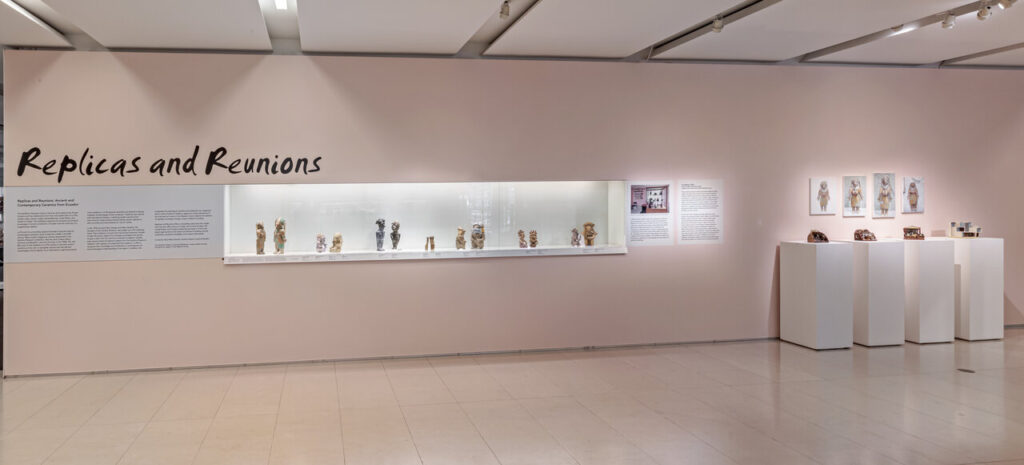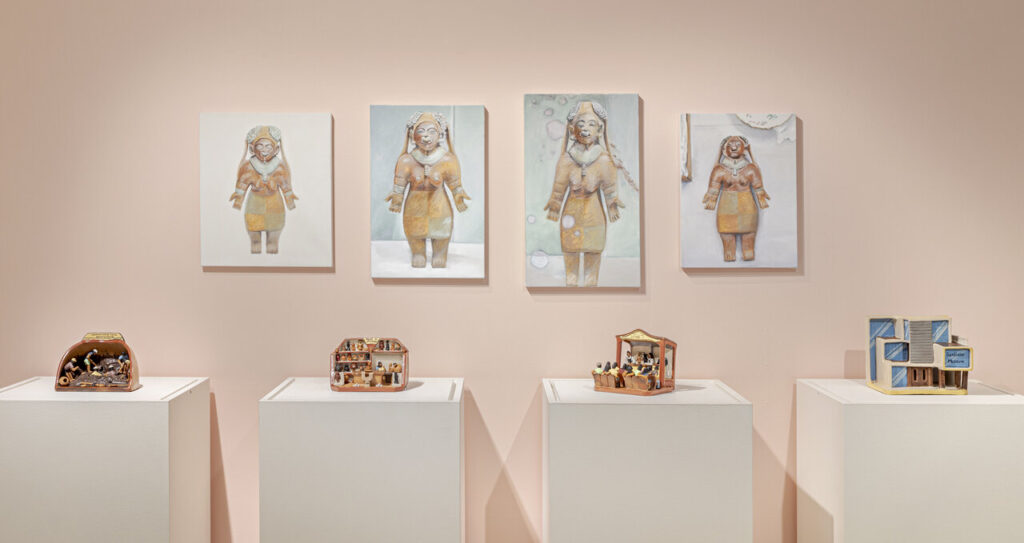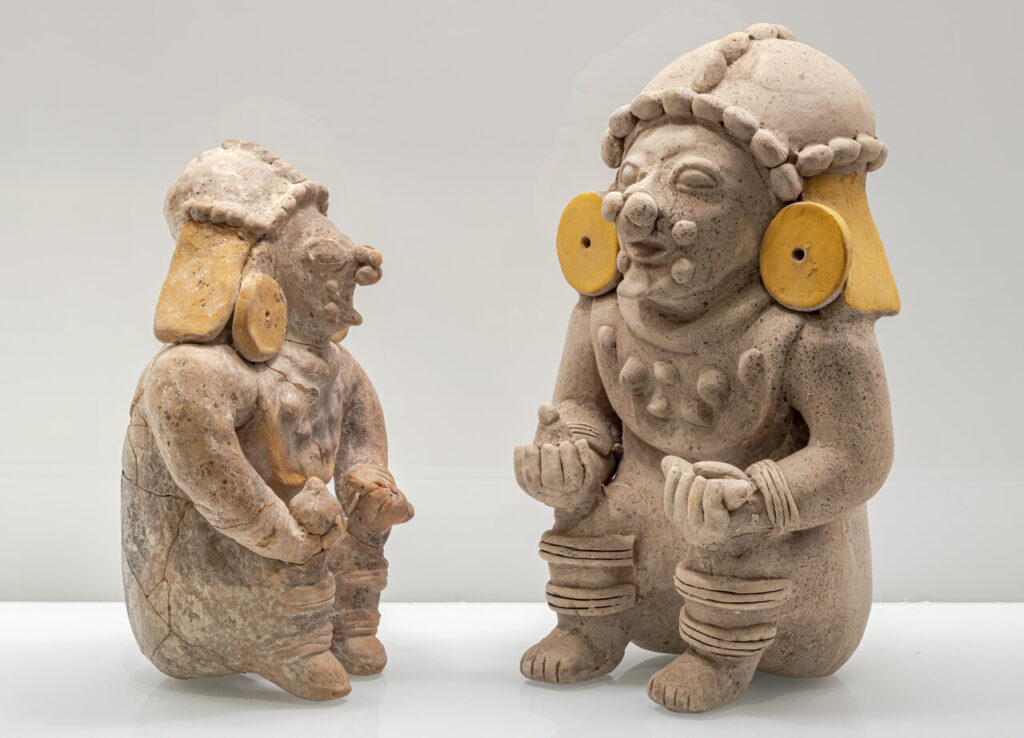Replicas and Reunions: Ancient and Contemporary Ceramics from Ecuador opened at the Gardiner Museum on November 10th, 2022, curated by Maya Wilson-Sanchez, the museum’s inaugural curatorial resident. The residency is promoted as an opportunity for emerging curators to conceive, research, and produce a small-scale exhibition in the gallery’s lobby. There is no other curatorial residency with professional and financial support such as this in all of Canada. Residents are provided funding to conduct two to four weeks of research travel outside of Canada—a feature of the program which informed the direction of the exhibition, as Wilson-Sanchez travelled to her home country of Ecuador, engaging deeply with both ancient and contemporary traditions in the coastal town of La Pila. There, she worked closely with artist, anthropologist and curator, Pamela Cevallos, who in 2018 founded the La Pila Historical and Craft Museum, which showcases replicas of pre-Columbian ceramics made by local artisans. The exhibition design for Replicas and Reunions appropriates the pink colour palette and hand-painted signage of this local museum, drawing on its playful visual language, taking on its conceptual approach as a ‘space under construction’, and forming a link between the two locales.
Exhibition view of Replicas and Reunions: Ancient and Contemporary Ceramics from Ecuador at the Gardiner Museum
La Pila and the Gardiner share a long, troubled, and unexpected history. During the 1970s and 1980s ceramics boom, residents of La Pila were urged to excavate ancient ceramics for international archaeologists and dealers, and encouraged to sell the ceramics held in their family collections to the Central Bank of Ecuador (this collection now forms part of the National Museum of Ecuador, in Quito). During this time of economic hardship, many residents also turned to the ceramic arts as an alternative to agricultural work. Returning to the craft of their ancestors, local artisans have been creating replicas of pre-Columbian sculptures to sell to clientele ranging from tourists to intermediaries with connections to international art markets in cities like New York. During this period, the founders of the Gardiner Museum, George and Helen Gardiner, were also swept up in the scramble for these artifacts, acquiring at least twenty-four Ecuadorian ceramics from US auction houses and dealers. These objects have their origins in ancient Indigenous cultures which once occupied La Pila and its surrounding regions, such as the Jama Coaque, Bahía, Chorrera and Manteño. Entangled in these capitalist and colonial systems, the objects tell of the history of colonial collection building and reveals the tensions between heritage, local appropriations, and colonial cultural extraction. Wilson-Sanchez has taken these objects from the Gardiner’s collection and paired them with replicas commissioned from a number of contemporary artisans based in La Pila – Andrés López, Genaro López, Daniel Mezones, Javier Rivera, and Guillermo Quijiji – in recognition of their technical expertise, contribution to the field of archaeology, and influence on contemporary art.
Pamela Cevallos with Guillermo Quijije, An Odyssey, 2022, Installation with ceramics scenes and oil painting on canvas
A series of four paintings by Cevallos speaks to the international transit of a particular object from the Gardiner’s collection, extending into the digital realm. These four images originate from a photograph first taken by an anonymous visitor to the Gardiner who photographed the ancient ceramic in the display case and uploaded the image to Wikipedia. It was not until Wilson-Sanchez sifted through the piles of print-outs stacked in Andrés López’s studio that she discovered López had been previously commissioned to create a replica based on this digital image. These four paintings represent four digital photographs: the image from Wikipedia, an image taken from the curator’s cellphone, the pristine photo found on the Gardiner’s website, and the stained printed image that López had kept for his records. Shown side by side, the intermedial nature of these works – at once object, photography and painting – explore questions of representation integral to art, and interrogates the idea of an exact reproduction. Is the prototype more real than the copy? What does it mean to produce a photograph of a ceramic, or a painting of a photograph? Could they too be understood as replicas?
Seated Figure with Hands on Knees, Jama Coaque Culture, Manabí, Ecuador, 200 BCE – 300 CE, Gift of George and Helen Gardiner (left) & Seated Figure with Hands on Knees, Andres Lopez, Manabi, Ecuador, 2022 (right)
Although playful in nature, this exhibition also does the important critical work of problematizing the binaries which have become so deeply engrained in museum theory and practice: the original vs. the copy, the historical vs. the contemporary, and the artist vs. the artisan. It raises the copy to the same value as the original, speaks to the contemporary revival of historical practices, and advances the status of the artisan as maker and scholar. Freed from these binaries, the histories of these objects also become circular in shape. This rhythmic display of mirrored forms highlights the relationships between the objects across time and space, as the contemporary replicas literally come face to face with their ancient prototypes. It also highlights the strength of the connection of the artisans to their ancient counterparts, and the longevity of both these ancient practices and the resilience of its people. These replicas are not mere copies. They are emergent from their own particular contemporary context and artisanal practices, have made their own journeys, and are the site of newly generated relationships and meanings.
The reunion of the objects in the Gardiner museum’s collections with their contemporary counterparts and compatriots represents a sort of homecoming—their absence within the vitrines of the permanent Andean displays is marked by new signs, ones which grant them agency and speak in their voice. Playing on the language of generic museum signage, one reads: “This object has been temporarily removed. It is reuniting with friends in the lobby”. Another reminisces, “It has been too much time since it heard the ocean”. This particular text refers to the legend surrounding Bahía Giants in the city of Manta, which tells of their discovery by sea when a storm unearthed thousands of them from shore. An ancient male Giant from the Gardiner’s collections faces a contemporary replica made by Javier Rivera, molded from earthenware and made using the same ancestral techniques. Facing one another instead of the audience, these sculptures address their own pasts and futures.
Male Effigy Figure, 2022, Javier Rivera, La Pila, Manabí, Ecuador (left) & Male Effigy Figure, Los Esteros, Manabí, Ecuador, Bahía Culture, 500 BCE-500 CE, Gift of George and Helen Gardiner (right)
As Wilson-Sanchez’s first on an Ecuadorian subject, this exhibition represents a sort of reunion for the curator as well. Her homecoming is marked by a desire to form relationships and engender reparative processes, between objects, people and even institutions. The ethos of care and generosity embedded in her practice comes through strong in this exhibition, as she lovingly rewrites these object histories. Pushing back against the ways in which Andean art has been traditionally displayed in the West – chronological, detached and anthropological in nature – this exhibition evokes poetry, intimacy, and deep kinship.
Emily Fu
Images are courtesy of the Gardiner Museum. Photo: Toni Hafkenscheid
*Exhibition information: Replicas and Reunions: Ancient and Contemporary Ceramics from Ecuador, November 10, 2022 – March 12, 2023, Gardiner Museum, 111 Queen’s Park, Toronto. Museum hours: Mon – Tue 10am – 5 pm, Wed 10am – 9pm (free 4 – 9pm), Thu – Fri 10 am – 6pm, Sat, Sun & Holidays 10am – 5pm.




